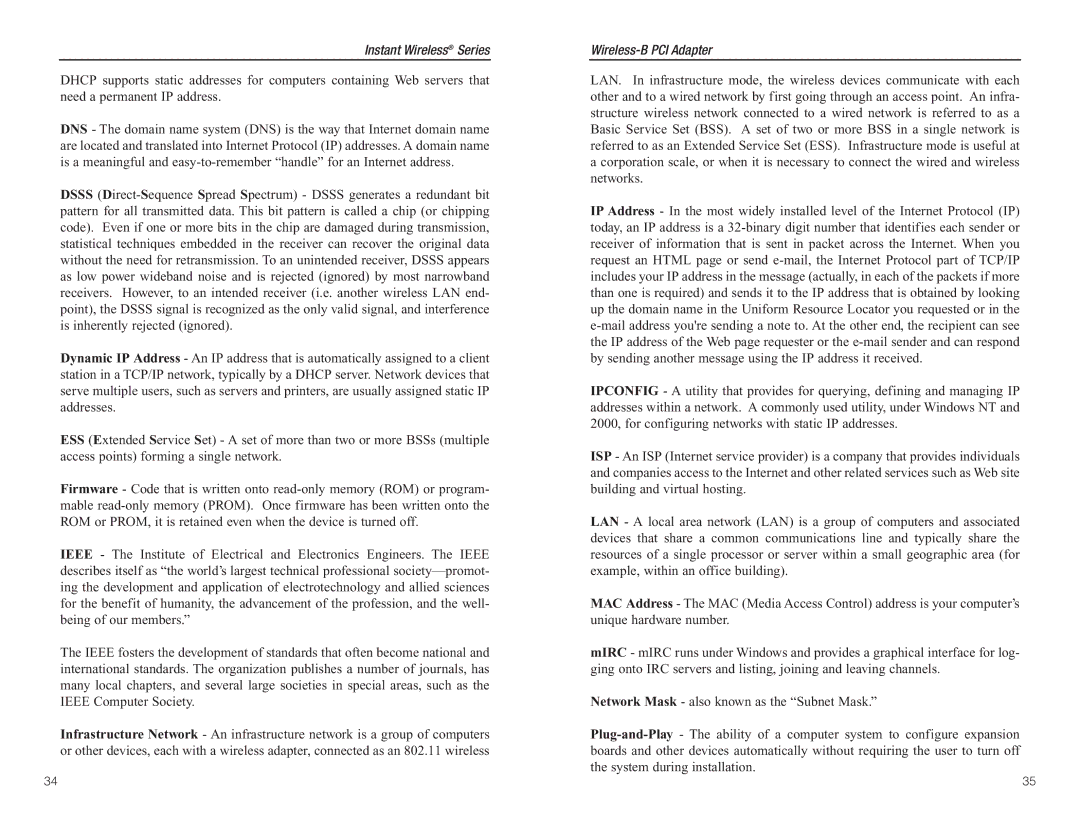Instant Wireless® Series
DHCP supports static addresses for computers containing Web servers that need a permanent IP address.
DNS - The domain name system (DNS) is the way that Internet domain name are located and translated into Internet Protocol (IP) addresses. A domain name is a meaningful and easy-to-remember “handle” for an Internet address.
DSSS (Direct-Sequence Spread Spectrum) - DSSS generates a redundant bit pattern for all transmitted data. This bit pattern is called a chip (or chipping code). Even if one or more bits in the chip are damaged during transmission, statistical techniques embedded in the receiver can recover the original data without the need for retransmission. To an unintended receiver, DSSS appears as low power wideband noise and is rejected (ignored) by most narrowband receivers. However, to an intended receiver (i.e. another wireless LAN end- point), the DSSS signal is recognized as the only valid signal, and interference is inherently rejected (ignored).
Dynamic IP Address - An IP address that is automatically assigned to a client station in a TCP/IP network, typically by a DHCP server. Network devices that serve multiple users, such as servers and printers, are usually assigned static IP addresses.
ESS (Extended Service Set) - A set of more than two or more BSSs (multiple access points) forming a single network.
Firmware - Code that is written onto read-only memory (ROM) or program- mable read-only memory (PROM). Once firmware has been written onto the ROM or PROM, it is retained even when the device is turned off.
IEEE - The Institute of Electrical and Electronics Engineers. The IEEE describes itself as “the world’s largest technical professional society—promot- ing the development and application of electrotechnology and allied sciences for the benefit of humanity, the advancement of the profession, and the well- being of our members.”
The IEEE fosters the development of standards that often become national and international standards. The organization publishes a number of journals, has many local chapters, and several large societies in special areas, such as the IEEE Computer Society.
Infrastructure Network - An infrastructure network is a group of computers or other devices, each with a wireless adapter, connected as an 802.11 wireless
Wireless-B PCI Adapter
LAN. In infrastructure mode, the wireless devices communicate with each other and to a wired network by first going through an access point. An infra- structure wireless network connected to a wired network is referred to as a Basic Service Set (BSS). A set of two or more BSS in a single network is referred to as an Extended Service Set (ESS). Infrastructure mode is useful at a corporation scale, or when it is necessary to connect the wired and wireless networks.
IP Address - In the most widely installed level of the Internet Protocol (IP) today, an IP address is a 32-binary digit number that identifies each sender or receiver of information that is sent in packet across the Internet. When you request an HTML page or send e-mail, the Internet Protocol part of TCP/IP includes your IP address in the message (actually, in each of the packets if more than one is required) and sends it to the IP address that is obtained by looking up the domain name in the Uniform Resource Locator you requested or in the e-mail address you're sending a note to. At the other end, the recipient can see the IP address of the Web page requester or the e-mail sender and can respond by sending another message using the IP address it received.
IPCONFIG - A utility that provides for querying, defining and managing IP addresses within a network. A commonly used utility, under Windows NT and 2000, for configuring networks with static IP addresses.
ISP - An ISP (Internet service provider) is a company that provides individuals and companies access to the Internet and other related services such as Web site building and virtual hosting.
LAN - A local area network (LAN) is a group of computers and associated devices that share a common communications line and typically share the resources of a single processor or server within a small geographic area (for example, within an office building).
MAC Address - The MAC (Media Access Control) address is your computer’s unique hardware number.
mIRC - mIRC runs under Windows and provides a graphical interface for log- ging onto IRC servers and listing, joining and leaving channels.
Network Mask - also known as the “Subnet Mask.”
Plug-and-Play- The ability of a computer system to configure expansion boards and other devices automatically without requiring the user to turn off the system during installation.
